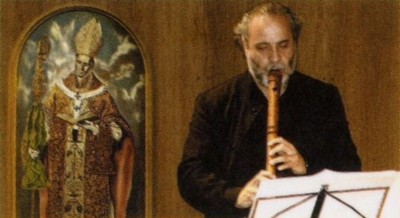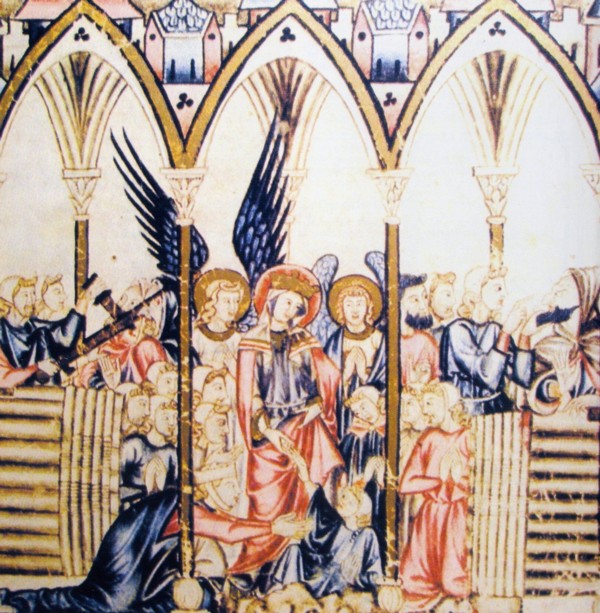Cantigas de Inglaterra • Cantigas of England
Alfonso X el Sabio, 1221-1284 /
Eduardo Paniagua

medieval.org
Pneuma «Colección Cantigas» PN-990
2007
1. EL MONJE EBRIO.
Virgen Santa Maria [5:20]
CSM 47
2. FUEGO EN MONT SAINT MICHEL.
Torto seria grand' e desmesura [9:59]
CSM 39
3. SAN DUSTAN.
A Madre de Jhesu-Cristo [5:01]
CSM 288
4. EL JUDÍO DE INGLATERRA.
Pera toller gran perfia [8:45]
CSM 85
5. LA HISTORIA DE ALIS Y FÉLIX.
Aquel podedes jurar [11:45]
CSM 135
6. DIABLOS COMO CERDOS.
[A Santa Maria mui bon servir faz ] [2:17]
CSM 82
7. EL NIÑO CANTOR.
A que do bon rey Davi [7:40]
CSM 6
8. EL MONJE DE CONTURBEL.
Quen aa Virgen santa [5:52]
CSM 296

MUSICA ANTIGUA
Eduardo Paniagua
César Carazo: canto
Isabel Urzaiz: canto
María Luz Álvarez: canto (CSM 47)
Pedro Adarraga, Luis Antonio Muñoz, David Cabrera, Emilio
Gómez, Pedro Llerena: coro (CSM 47)
Jaime Muñoz: ajabeba, flauta doble, flautas y gaitas
David Mayoral: darbuga, tambor, panderos, panderetas y daf
Eduardo Paniagua: salterio, dulcimer, flautas dulces, campanil,
gong, arpa de boca y semillas y flautas
Josep María Ribelles: arpa
Ana Alcaide: viola de teclas
Carlos Beceiro: zanfona
Wafir Sheik: suisen y laúd
Manuel Pascual: corneta
Luis Delgado: pandero (CSM 288)
Enrique Almendros: gaita charra y tamboril (CSM 288)
Grabado en febrero-junio de 2007 en Axis, Madrid, por Hugo Westerdhal
Diseño gráfico: Pneuma
Portada: Miniatura de la Cantiga 135, La historia de Alix y Felix
Bandeja interior: Miniatura 3 de la Cantiga 39, Fuego en el Mont Saint-Michel y
Miniatura 7 (Paraíso) de la Cantiga 85, El judío de Inglaterra
Traducción poemas: José Filgueira y Jesús Montoya
English translation: Lesley Ann Shuckburgh
Producción: EDUARDO PANIAGUA • 2007 PNEUMA
Depósito Legal: M-41024-2007
Dirección General de Promoción Cultural
CONSEJERÍA DE CULTURA Y DEPORTES
Comunidad de Madrid
English liner notes

CANTIGAS DE INGLATERRA
Las Cantigas de Inglaterra son canciones del siglo XIII,
complementarias a las incluidas en el CD “Merlín y otras
Cantigas Celtas” (Pneuma PN-820). Músicas hechas en el
Reino de Castilla, León y Andalucía que cantan sucesos
recogidos en las dos Bretañas, la mayor y la menor. Historias de
monjes y judíos ingleses, en las que aparece la música
como fondo, ya sea en cantos celestiales o de un niño cantor.
Estas maravillosas cantigas de Canterbury y de otros lugares componen
este repertorio inédito que constituye una rara muestra de
Inglaterra en el cancionero alfonsí.
1 - CSM 047. EL MONJE EBRIO
Un monje que observaba bien sus reglas, sin embargo, bebía
demasiado en la bodega. Ebrio fue a la iglesia apareciéndosele
el demonio amenazante con figuras de toro, hombre y león. Santa
María le socorrió golpeando al diablo cada vez,
quitándole el miedo del demonio y el vicio del vino que le
enloquecía.
2 - CSM 39. FUEGO EN MONT SAINT MICHEL
En el monasterio de San Miguel de Tumba (Mont Saint-Michel) cae un rayo
y se produce un gran incendio. Todo se quema en la iglesia a
excepción de la imagen de Santa María con su velo, que no
quedó siquiera ahumado.
3 - CSM 288. SAN DUSTAN
El protagonista de esta cantiga tiene una visión mística
con cantos celestiales. Se trata de San Dustan, abad durante los
años 961 a 988, del monasterio de San Agustín de
Canterbury; benedictino enviado en el siglo sexto por el Papa Gregorio
I a evangelizar Inglaterra.
4 - CSM 85. LA CONVERSIÓN DEL JUDÍO DE INGLATERRA
Santa María libera en Inglaterra a un judío de la
prisión y maltrato que le dan unos ladrones cristianos. Primero
le muestra la diferencia entre los castigos que sufren las almas de los
judíos y la gloria del Paraíso de los cristianos. Luego
le lleva a un monasterio donde es bautizado por el abad. Recurrente
descripción de los castigos del infierno y tópica
alusión a la judía abstención de la carne de cerdo.
5 - CSM 135. LA HISTORIA DE ALIX Y FELIX
Esta cantiga es como un cuento o una pequeña novela donde los
jóvenes protagonistas: Alis y Félix, en Bretaña la
Menor, son prometidos en nupcias ante la Virgen cuando eran
niños. Luego ambos sufren casamiento forzado por sus padres. Por
mediación de la Virgen, y tras muchas aventuras, los amantes
logran casarse y acaba bien el cuento, cuando “en solaz, el novio
hizo lo que hace el novio a la novia”. Cantiga
“grande” como corresponde a las de número
múltiplo de cinco, con 19 estrofas de siete versos de metro
ligero, casi improvisado y de rima variada, y con muchos
diálogos apropiados para ser recitados.
6 - CSM 82. DIABLOS COMO CERDOS
La Virgen María salva a un monje que en sueños es atacado
por diablos en forma de cerdos y jabalíes. La narración
se localiza en Canterbury. Interpretada instrumentalmente, está
cantada en el CD “Bestiario” Cantigas de animales (Pneuma PN-340)
7 - CSM 6. EL NIÑO CANTOR
Santa María resucita a un apuesto chiquillo cantor, hijo de una
viuda, después de que un judío de Lincoln le matara con
un hacha por cantar el “Gaude Virgo María”. El
pueblo actúa contra el asesino en reacción antisemita.
8 - CSM 296. EL MONJE DE CONTURBEL
Esta cantiga procede de la tradición monacal de Canterbury.
Santa María se aparece a un monje para enseñarle como
servirla: primero amarla de corazón, luego honrarla y
después loarla siempre.
Eduardo Paniagua

CANTIGAS OF ENGLAND
THE CANTIGAS OF ENGLAND are songs from the 13th century and are
complementary to the ones iIncluded on "Merlin y otras Cantigas Celtas"
(Pneuma PN-820). Created in the kingdoms of Castile, Leon and Andalusia
they refer to events concerning Britain and Brittany. Stories of English
monks and Jews in which music features as a backdrop, either in
heavenly chants or through the voice of a boy singer. These marvellous
Cantigas of Canterbury and other places make up this previously
unrecorded repertoire that constitutes a rare example of England in the
Alphonsine songbook.
The Codices of the Cantigas in
Galician-Portuguese poetry were created in the court of Alfonso X el
Sabio (the Wise) I 253-1284, one of the major fruits of the literature
of the time and the most important collection of melodies in the Europe
of the 13th century.
Eduardo Paniagua
1. CSM 147. THE INEBRIATE MONK
A
monk who normally obeyed the rules, drank too much in the wine cellar.
Drunk, he went to the church and the devil appeared to him threatening
him with figures of a bull, a man and a lion. Holy Mary came to his aid
hitting the devil each time, taking the fear of the demon and the vice
of wine from him that were driving him mad.
2. CSM 39. THE FIRE ON THE MONT SAINT-MICHEL
The
monastery of St. Michael of Tomb (referring to Mont Tombe later known
as Mont Saint-Michel) is struck by lightening and a great fire breaks
out. Everything is burnt in the church except the image of the Virgin
Mary with her veil, which was not even affected by the smoke.
3. CSM 288. ST. DUNSTAN
The protagonist of this cantiga
has a mystical vision with celestial chants. It is St. Dunstan, abbot
from 961 to 988 of the monastery of St. Augustin of Canterbury, the
Benedictine monk sent by the Pope Gregory I in the sixth century to
preach the Gospel in England.
4. CSM 85. THE CONVERSION OF THE JEW OF ENGLAND
The
Virgin Mary frees a Jew from prison and ill treatment on the part of
some Christian thieves in England. First She shows him the difference
between the punishments that Jewish souls suffer and the glory of
Christian Paradise. Then She takes him to a monastery where he is
baptised as Abbot. A recurrent description of the punishments of hell
and a topical allusion to the Jewish abstention from pork.
5. CSM 135. THE STORY Of ALICE AND FELIX
This cantiga
is like a story or short novel, which takes place in Brittany. The
young protagonists Alice and Felix, are betrothed before the Virgin when
they are children but are then both forced to marry by their parents.
With the help of the Virgin, and after many adventures, the lovers
manage to marry and the story ends happily, when "at leisure, the groom
did what a groom does to a bride''. A "great" Cantiga as are all
those whose number is a multiple of five, with 19 verses of seven lines
in light metre, almost improvised and with varying rhyme, and including
many dialogues that can be recited.
6. CSM 82. DEVILS IN THE FORM OF PIGS
The booklet repeats the description of track 7, CSM 6. —
Free translation from the Spanish section of the booklet:
The
Virgin Mary saves a monk who in dreams is attacked by devils in the
form of pigs and wild boars. The narrative is located in Canterbury.
Instrumentally performed, it is sung in the CD "Bestiario" Cantigas de
animales (Pneuma PN-340).
7. CSM 6. THE BOY SINGER
The
Blessed Virgin Mary resurrects a smart little singer, son of a widow,
after a Jew from Lincoln kills him with an axe for singing "Gaude Virgo
Maria". The people attack the murderer in an anti-Semitic reaction.
8. CSM 296. THE MONK OF CONTURBEL
This cantiga
is from the monastic tradition of Canterbury. The Virgin Mary appears
to a monk to teach him how to serve Her: first by loving Her from the
heart, then by honouring Her and lastly by praising Her always.





